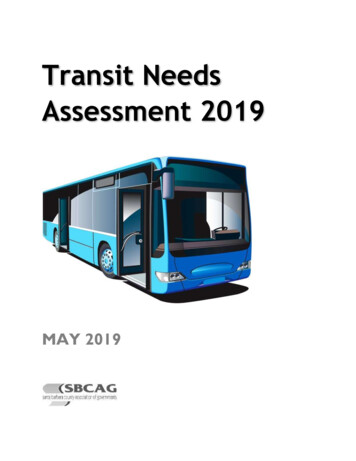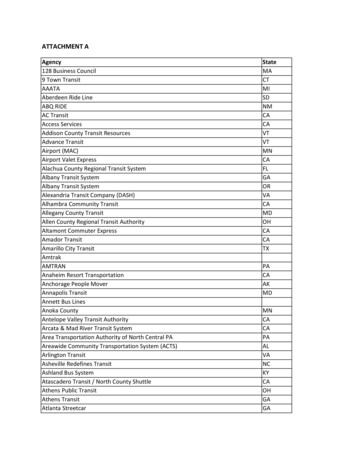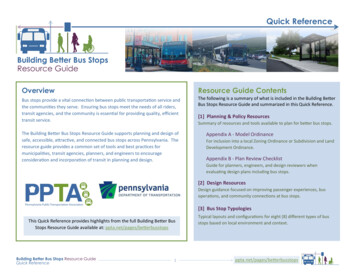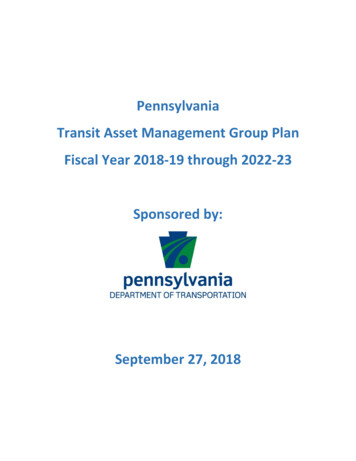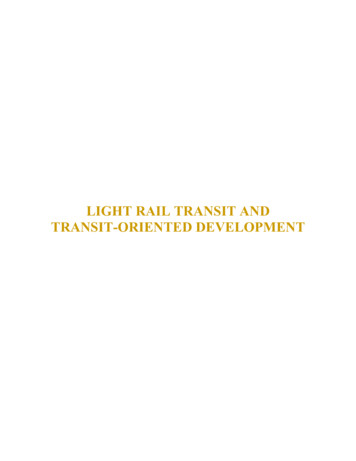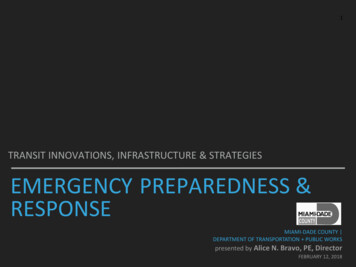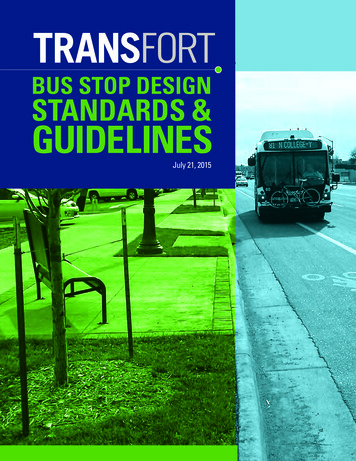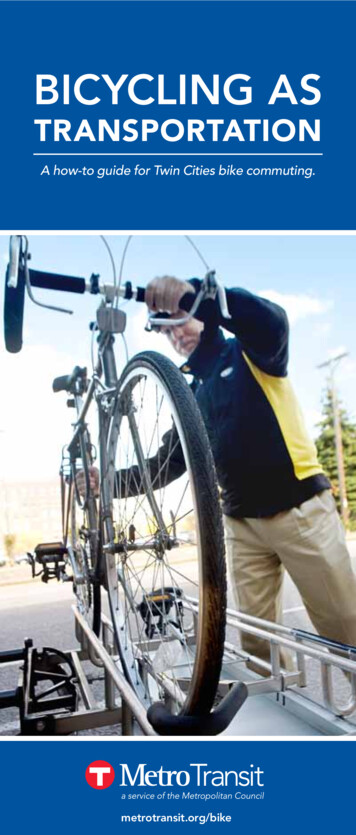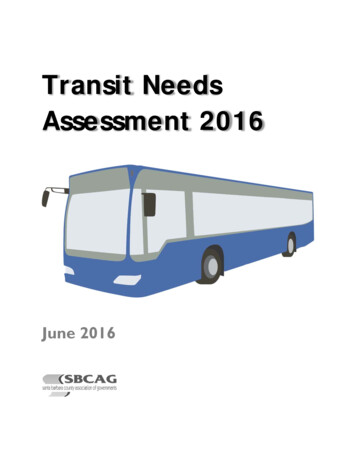
Transcription
Transit NeedsAssessment 2016June 2016
Transit Needs Assessment 2016Project StaffJim KempExecutive DirectorPeter ImhofDeputy Executive Director, PlanningMichael BeckerSenior Transportation PlannerSanta Barbara County Association of Governments260 North San Antonio Road, Suite BSanta Barbara, CA, 93110(805) 961-8900www.sbcag.orgFinancial support for the preparation of this report was provided by the State of California.
2016 Membership RosterSUPERVISORSMemberSupervisorial DistrictSALUD CARBAJALFIRST DISTRICTJANET WOLF (Chair)SECOND DISTRICTDOREEN FARRTHIRD DISTRICTPETER ADAMFOURTH DISTRICTSTEVE LAVAGNINOFIFTH DISTRICTCITIESMemberAlternateBUELLTONHOLLY SIERRAED ANDRISEKCouncilmemberMayorAL CLARKWADE NOMURACouncilmemberCouncilmemberMICHAEL BENNETT (Vice Chair)ROGER ACEVESCouncilmemberCouncilmemberJOHN LIZALDEJERRY BEATTYMayorCouncilmemberJAMES MOSBYBOB LINGLCouncilmemberMayorHELENE SCHNEIDERBENDY WHITEMayorCouncilmemberALICE PATINOETTA WATERFIELDMayorCouncilmemberJIM RICHARDSONED OMPOCSANTA BARBARASANTA MARIASOLVANGEX-OFFICIO (NON-VOTING) MEMBERSCALTRANS DISTRICT 5TIM GUBBINS19th SENATE DISTRICTHANNAH BETH JACKSON35th ASSEMBLY DISTRICTKATCHO ACHADJIAN37th ASSEMBLY DISTRICTDAS WILLIAMS
This page is intentionally left blank.
With Special RecognitionSanta Barbara County Transit Advisory Committee(SBCTAC)Representative of:Voting MemberLOCAL SOCIAL SERVICE PROVIDERS FOR PERSONSWITH DISABILITIESBleavins, PollyLOCAL CTSA - Easy LiftCampos, Nicole (SC)LOCAL SOCIAL SERVICE PROVIDERS FOR PERSONSOF LIMITED MEANSDiaz, Lee (NC)POTENTIAL TRANSIT USERS WHO IS 60 YEARS OFAGE OR OLDERFisher, Sherrie (SC)AGRICULTURAL WORKERSKeller, Fred (NC)TRANSIT USERS FROM SOUTHERN SANTA BARBARACOUNTYKraus, Howard (SC)LOCAL SOCIAL SERVICE PROVIDERS FOR SENIORSLöwen, PetraIndependent Living Resource Center (SC)CITY OF LOMPOC TRANSIT (COLT)Luther, Michael (NC)SANTA BARBARA METROPOLITAN TRANSITDISTRICT (MTD)Maas, Steve (SC)LOCAL SOCIAL SERVICE PROVIDERS FOR SENIORSCommunity Partners in CaringPayne, Ashley(NC)LOCAL CTSA - SMOOTHSimas, Fil (NC)COUNTY TRANSITDobberteen, Matt (NC)POTENTIAL TRANSIT USERS WHO HAS A DISABILITYStotts, Barry (NC)LOCAL SOCIAL SERVICE PROVIDERS FOR PERSONSWITH DISABILITIESSuhr, Victor (SC)GUADALUPE TRANSITTalbott, Jim (NC), Vice ChairSANTA YNEZ VALLEY TRANSIT (SYVT)van der Linden, Matt (NC), ChairSANTA MARIA AREA TRANSIT (SMAT)Valdez, Eustaquio (NC)TRANSIT USERS FROM NORTHERN SANTA BARBARACOUNTYZoost, Ed (NC)Children and Families Commission (NC)
This page is intentionally left blank.
Table of ContentsExecutive Summary .1Chapter 1.Introduction.3Chapter 2.Consultation .5Chapter 3.Assessment of Population Characteristics .7General Population .7Vehicle Access . 7Transit Dependency Indicator: Age.9Transit Dependency Indicator: Disability . 10Transit Dependency Indicator: Income . 10Transit Demand/Needs . 11Chapter 4.Transportation Services . 13Fixed Route, Demand Response, and Commuter Transportation Services . 13Intercity Transportation Services . 21Specialized Transportation Services . 22Analysis of Transportation Services . 24Chapter 5.Service Expansions & Improvements . 27Chapter 6.Transportation Needs Assessment & Findings . 29Public Input . 29Analysis . 30Unmet Transit Needs Analysis . 35Reasonable to Meet Analysis . 43Findings . 47Appendix A: Acronyms & Definitions . iAppendix B: Demographic Tables . iiiAppendix C: SBCAG Public Outreach Materials . xiiiAppendix D: Transit Agency Workshops . xxvCity of Lompoc Transit (COLT) Workshop . xxvSanta Maria Area Transit (SMAT) Workshop . xxviiAppendix E: SBCAG Public Hearing Comments . xlviiAppendix F: Other Public Comments. xlixLetters . xlixE-Mail . lvAppendix G: SBCAG Resolution . lxvi
TablesTable 1: Transit Dependency Indicators .8Table 2: Transit Systems in Santa Barbara County (does not include CTSAs) . 19Table 3: Transit Ridership, FY 2010/11 to FY 2014/15. 20Table 4: Areas Served by Transit . 26Table 5: Requests Not Applicable to the Transit Needs Assessment . 31Table 6: FY 2014/15 Farebox Recovery Ratios . 34Table 7: Requests for New or Expanded Service . 35Table 8: Comments that are Not Unmet Transit Needs . 35Table 9: Comments that are Not Applicable to the Transit Needs Assessment . 37Table 10: Preliminary Calculations Additional Mid-Day Afternoon Service on Breeze 100 . 44Table 11: Preliminary Calculations for Dial-a-Ride Service between the Santa Ynez Valley and SantaMaria . 45Table 12: Preliminary Calculations for Four Additional Round-Trips between the Bridge House Shelterand Lompoc . 46Table 13: Population . iiiTable 14: Race . ivTable 15: Hispanic or Latino Population. vTable 16: Vehicle Availability by Occupied Housing Unit . viTable 17: Enrollment in Santa Barbara County Public School Districts, 2014-15 . viiTable 18: Higher Education Enrollment in Santa Barbara County . viiTable 19: Population with a Disability . viiiTable 20: Poverty Status . ixTable 21: Labor Market Indicators, 2015 Monthly. xFiguresFigure 1: Transit Needs Assessment Flowchart .4Figure 2: Santa Barbara County Age Distribution .9Figure 3: Unemployment Rate, Incorporated Cities . 11Figure 4: Total Transit Ridership, FY 2010/11 to FY 2014/15 . 20Figure 5: Definition—Unmet Transit Need. 31Figure 6: Criteria—Reasonable to Meet . 32Figure 7: Breeze 100 & 200 Route Map . 43
EXECUTIVE SUMMARYThe California Transportation Development Act(TDA) provides two major sources of annualfunding for public transportation—the LocalTransportation Fund (LTF) and the State TransitAssistance fund (STA). SBCAG, as the RegionalTransportation Planning Agency (RTPA) forSanta Barbara County, administers TDA fundingwithin the region. Transit is the priority use forthese funds. If a claimant requests TDA fundsfor non-transit (i.e., streets and roads)purposes, SBCAG must first determine whetheror not there are “unmet transit needs” that are“reasonable to meet” within the claimant’sjurisdiction.The County of Santa Barbara, as therepresentative for the unincorporated NorthCounty, plans to request FY 2016-17 TDA fundsfor non-transit purposes. Therefore, SBCAGconducted the 2016 transit needs assessment todetermine whether or not there are unmettransit needs that are reasonable to meetwithin the unincorporated North Santa BarbaraCounty.According to regulation, SBCAG must consultwith the Social Services Transportation AdvisoryCouncil (SSTAC). The Santa Barbara CountyTransit Advisory Committee (SBCTAC) isSBCAG’s SSTAC. SBCAG consulted with SBCTACregarding outreach efforts, public outreachmaterials, and public input received. This yearthe committee received a summary of thefeedback from the SMAT and COLT unmet needsworkshops, which were convened in SantaMaria and Lompoc in late 2015. SBCAG staffalso provided SBCTAC with a summary of thecomments received at the SBCAG unmet transitneeds hearings in January and April.SBCAG must also perform an assessment of thesize and location of identifiable groups likely tobe transit-dependent or transit-disadvantagedin Santa Barbara County. The young, theelderly, persons with disabilities, and personsof limited means are more likely than thegeneral population to be transit-dependent.The unincorporated areas of the Santa Mariaand Santa Ynez Valleys have high percentagesof seniors. The unincorporated area of theSanta Maria Valley has a high percentage ofresidents with disabilities. The unincorporatedCuyama area has high percentages ofpopulation below the poverty level.SBCAG must also analyze existingtransportation services. There are a variety offixed route, demand response, commuter,intercity, and specialized services providingtransportation in every region in the County.61% of the County’s population lives within ¼mile of a bus stop and 81% of the populationlives within ½ mile of a bus stop. 82% of theCounty’s jobs are within ¼ mile of a bus stop.Transit operators in Santa Barbara Countycontinually evaluate, expand, and improveservice to meet the demands of the population.Examples of successful new services include theBreeze Bus, the Wine Country Express, andGuadalupe Flyer Sunday service.SBCAG conducted two public hearings toidentify remaining demand for new andexpanded transit service. SBCAG also acceptedpublic input through transit agency workshops,e-mail, mail, and telephone. The applicablerequests for new or expanded service this yearwere for both regional and interregional transitservice. The regional and interregional transitrequests can be challenging to operate and tofund because the affected jurisdictions mustnegotiate operating and cost-sharingagreements.Using the definition adopted by the SBCAGBoard, SBCAG identified some public commentsand requests for service expansion that qualifyas potential “unmet transit needs.” Applyingthe criteria adopted by the SBCAG Board,SBCAG determined, however, that theidentified unmet transit needs are not“reasonable to meet.”Santa Barbara County Association of Governments 1
Transit Needs Assessment 2016Thus SBCAG finds that there are no unmettransit needs that are reasonable to meet.With this finding, the County of Santa Barbara,as the representative of the unincorporatedNorth County, may use FY 2016-17 TDA fundsfor non-transit purposes as requested. Thisfinding does not, however, preclude agenciesfrom voluntarily coordinating to fulfill any ofthe requests for new or expanded service. Ifimplemented voluntarily, the requests canprovide direction for improving transit servicein Santa Barbara County.2
CHAPTER 1. INTRODUCTIONThe California Transportation Development Act (TDA) provides two major sources of annual funding forpublic transportation—the Local Transportation Fund (LTF) and the State Transit Assistance fund (STA).The Santa Barbara County Association of Governments (SBCAG), as the Regional TransportationPlanning Agency (RTPA) for Santa Barbara County established by California Government Code Section99401, administers the TDA within the region, allocating TDA funds to eligible claimants (the cities, theCounty, and transit operators) within its jurisdiction.Transit is the priority use for TDA funds. TDA STA funds may only be used for transit. TDA LTF fundsmay be used, under TDA Article 8, for transit services, streets and roads, or pedestrian and bicycleprojects; however, LTF funds may be used for streets and roads purposes only if there are no unmettransit needs that are “reasonable to meet.”If a claimant requests to use LTF funds for streets and roads purposes, SBCAG must first determinewhether or not there are unmet needs that are reasonable to meet within the claimant’s jurisdiction.To make this determination, SBCAG must perform an assessment of regional transit needs. Theassessment, as designated by the California Public Utilities Code (PUC) Section 99401.5, requires SBCAGto: Consult with the Social Services Transportation Advisory Council (SSTAC) established pursuant toPUC Section 99238. Santa Barbara County’s SSTAC is the Santa Barbara County Transit AdvisoryCommittee (SBCTAC). Identify the transit needs of the jurisdiction(s) that have been considered as part of thetransportation planning process, including the following: oAn assessment of the size and location of identifiable groups likely to be transit-dependentor transit-disadvantaged, including but not limited to the elderly and persons withdisabilities, individuals eligible for paratransit and other special transportation services,and persons of limited means.oAn analysis of the adequacy of existing public transportation and specialized transportationservices, including privately and publicly provided services, to implement the plan to meetidentified transit demand.oAn analysis of potential alternative public transportation and specialized transportationservices and service improvements that would meet all or part of the transit demand.Identify the unmet transit needs of the jurisdiction and those needs that are reasonable to meet.o Conduct at least one public hearing for the purpose of soliciting comments on unmettransit needs that may exist within the jurisdiction and that might be reasonable to meetby establishing or contracting for new public transportation or specialized transportationservices or by expanding existing services.Adopt by resolution a finding for the jurisdiction after consideration of all available informationthat:oThere are no unmet transit needs,oThere are no unmet transit needs that are reasonable to meet, oroThere are unmet transit needs, including needs that are reasonable to meet.Santa Barbara County Association of Governments 3
Transit Needs Assessment 2016If SBCAG adopts a finding that there are unmet transit needs that are reasonable to meet within ajurisdiction requesting LTF funds for non-transit purposes, the unmet transit needs shall be fundedbefore allocating any funds for streets and roads purposes within that jurisdiction. Only upon adoptionof a finding that there are “no unmet transit needs” or that there are “no unmet transit needs that arereasonable to meet” may SBCAG allocate funds for streets and roads purposes.The figure below illustrates the transit needs assessment process.Figure 1: Transit Needs Assessment Flowchart4
CHAPTER 2. CONSULTATIONConsult with the Social Services Transportation Advisory Council (SSTAC) established pursuant toPUC §99238. Santa Barbara County’s SSTAC is the Santa Barbara County Transit AdvisoryCommittee (SBCTAC).The first step in the Transit Needs Assessment process is to consult with the SSTAC, which, for SBCAG,is the Santa Barbara County Transit Advisory Committee (SBCTAC). This chapter describes SBCAG’sconsultation with SBCTAC. It also explains SBCAG’s other consultation efforts. (The public hearings andother public outreach efforts are discussed in Chapter 6.)SBCTAC was established as Santa Barbara County’s SSTAC in 2002 in accordance with PUC Section99238.1 SBCTAC is composed of transit users, representatives from fixed route transit and paratransitagencies, and representatives from social service agencies that serve seniors, persons with disabilities,and persons of limited means. SBCTAC meets monthly, as needed, to identify and discuss issuesregarding transit needs, and to review and recommend actions to SBCAG as the RTPA. SBCTAC advisesSBCAG on the annual transit needs assessment and other major transit issues, including thecoordination and consolidation of specialized transportation services.SBCTAC met to discuss the 2016 Transit Needs Assessment process on September 9, 2015. SBCTACdiscussed options for and provided direction on the public outreach strategy. The committee received areport on plans for local agency transit workshops and other public input gathering. The committeealso approved the type, design, and distribution of public outreach materials (see Appendix C: PublicOutreach Materials).SBCTAC received a presentation on input from the SMAT and COLT public workshops on February 10,2016. SBCTAC also received a summary of input from the SBCAG January 21 public hearing and inputreceived by letter and e-mail; and discussed next steps at the same meeting.PUC §99238 states, “Each transportation planning agency shall provide for the establishment of a social servicestransportation advisory council for each county, or counties operating under a joint powers agreement, which isnot subject to the apportionment restriction established in Section 99232.” Committee members must includerepresentation from potential transit users who are 60 years of age or older; potential transit users who havedisabilities; social service providers for seniors, persons with disabilities, and people of low income; and, ifapplicable, social service transportation providers for seniors and persons with disabilities, and the localconsolidated transportation service agency (CTSA).1Santa Barbara County Association of Governments 5
Transit Needs Assessment 20166
CHAPTER 3. ASSESSMENT OF POPULATION CHARACTERISTICSIdentify the transit needs of the jurisdiction(s) that have been considered as part of thetransportation planning process, including: An assessment of the size and location of identifiable groups likely to be transit-dependent ortransit-disadvantaged, including but not limited to the elderly and persons with disabilities,including individuals eligible for paratransit and other special transportation services, andpersons of limited meansThe next step in the Transit Needs Assessment process, described in this Chapter, is to assess thepopulation of Santa Barbara County to identify and locate groups likely to be transit-dependent ortransit-disadvantaged. Being transit-dependent means having to rely on transit services instead of theprivate automobile to meet one's travel needs. Transit-dependent persons generally either do not haveaccess to a vehicle or are unable to operate a vehicle. The elderly, the young, persons with disabilities,and low-income individuals are more likely than the general population to be transit-dependent.GENERAL POPULATIONAccording to the 2010 Census, the population of Santa Barbara County is 423,895 (see Table 13 inAppendix B: Demographic Tables). Santa Maria is the largest city in the County. The County’spopulation is growing, with the North County growing more quickly than the South Coast. Guadalupe,Buellton, and Santa Maria are expected to see the most growth between 2010 and 2040, and SantaMaria is expected to remain the largest city.Seventy percent of Santa Barbara County’s population is solely white (see Table 14). Two percent issolely black or African American, one percent is solely American Indian and Alaska Native, five percentis solely Asian, less than one percent is solely Native Hawaiian and other Pacific Islander, andseventeen percent is other. Five percent of Santa Barbara County’s population identifies as being oftwo or more races.Regarding ethnicity, 43% of people of any race identify as Hispanic or Latino (see Table 15). Guadalupehas the highest percentage of its residents identifying as Hispanic or Latino—86% (see Table 15). SantaMaria ranks second at 70%, but has the largest number of Hispanics/Latinos at 70,114. The majorityHispanic/Latino population in Guadalupe and Santa Maria may be attributed in part to establishedcommunities, employment opportunities, and lower housing costs. In Lompoc, 51% of the populationidentifies as Hispanic or Latino. Unincorporated North County is the only jurisdiction in Santa BarbaraCounty not dedicating all TDA funds to transit in the FY 2016/17 cycle; 26% of the residents ofunincorporated North County identify as Hispanic or Latino.VEHICLE ACCESSNearly 7% of the occupied housing units in the County have no vehicle, according to the AmericanCommunity Survey (see Appendix B). Of the incorporated cities, Santa Barbara and Lompoc have thehighest percentage of occupied housing units, both at 9.8%, with no vehicle. 2.5% of occupied housingunits in the unincorporated North County have no vehicle.Santa Barbara County Association of Governments 7
Transit Needs Assessment 2016Limited vehicle access may be by choice, or may be due to one or more of the factors mentionedearlier—age, disability, and poverty. Table 1: Transit Dependency Indicators displays transitdependency indicators by city.Table 1: Transit Dependency IndicatorsTotal PopulationAge 14 & Under#Age 65 & Over%*#%*Disability#%**Poverty#%***City of Buellton4,92492119%61813%2976%49310%City of 6024%15414%9810%28126%2223918%188%146%6127%Uninc. Lompoc Valley15,7893,54222%2,36515%1,72213%1,0417%Uninc. Santa Maria Valley34,1456,78920%6,15218%4,35714%2,3597%Uninc. Santa Ynez Valley11,5961,47713%2,05318%2,54923%1,0559%Total Uninc. North County62,82312,10819%10,74217%8,74015%4,7978%City of ty of Goleta30,3334,79216%4,30714%2,657n/a2,3248%City of Santa tal South County otal Uninc. South 5581,49619%57,64113%43,73211%68,95317%City of LompocCity of Santa MariaCity of SolvangTotal North County CitiesUninc. Cuyama AreaUninc. Guadalupe AreaTotal Santa Barbara County*of the total population (431,555 Total)**of the civilian noninstitutionalized population, age 5 (396,697 Total)The institutionalized population is persons residing in institutional group quarters such as adult correctional facilities,juvenile facilities, skilled-nursing facilities, and other institutional facilities***of the population for whom poverty status is determined (414,198 total)Age Source: U.S. Census Bureau, 2010-2014 ACSDisability Source: U.S. Census Bureau, 2010-2014 ACSPoverty Source: U.S. Census Bureau, 2010-2014 American Community SurveyThe table indicates the presence of significant populations of young, elderly, disabled, andimpoverished in various areas throughout the region. Each of the transit dependency indicators isdiscussed in more detail below.8
TRANSIT DEPENDENCY INDICATOR: AGEAs previously mentioned, the elderly and the young are more likely than the general population to betransit-dependent. Seniors (65 and over) and young people (14 and under) account for approximately32% of the County’s population (see Table 1: Transit Dependency Indicatorsabove).The areas with the youngest people as a percentage of the population are the Cities of Guadalupe,Santa Maria, and the unincorporated Cuyama area. The areas with the most seniors as a percentage ofthe population are the Cities of Solvang and Carpinteria, and the unincorporated area of the SantaMaria Valley. Of these areas, the unincorporated North County does not use all TDA funds for transit.The number of seniors is growing at a faster rate than other age groups. The figure below shows theforecast change in countywide age distribution from 2010 to 2040.Figure 2: Santa Barbara County Age Distribution2Many young people are students (see Table 17 and). California Vehicle Code Section 12814.6 prohibitsmost young drivers (under age 18) from carrying other young passengers, limiting carpooling to schooltrips and thereby increasing the need for transit.2 State of California, Department of Finance Demographic Research Unit, Report P-2 State and County PopulationProjections by Race/Ethnicity and Age 2010-2060, Sacramento, California, January 31, 2013.Santa Barbara County Association of Governments 9
Transit Needs Assessment 2016TRANSIT DEPENDENCY INDICATOR: DISABILITYAs mentioned above, persons with disabilities are more likely than the general population to be transitdependent. For the purposes of the American Community Survey, a person is considered to have adisability if he or she has difficulty performing certain functions—seeing, hearing, walking, climbingstairs, reaching, lifting, carrying, learning, remembering, concentrating, dressing, bathing, gettingaround the home, leaving the home alone to shop or visit the doctor, or working.3According to the 2010-2014 American Community Survey, 11% of residents in Santa Barbara County areliving with a disability (see Table 1). The City of Solvang and the unincorporated area around SantaMaria have the highest percentage of the population having a disability, at 14%. With the exceptions ofthe City of Buellton, the unincorporated Guadalupe area, and the unincorporated South Coast, theremainder of the county has disabled rates of 10% or higher. The North County, as a whole, has adisability rate of approximately 11%. Of these areas, the unincorporated North County does not use allTDA funds for transit.TRANSIT DEPENDENCY INDICATOR: INCOMEAs mentioned above, low-income individuals are more likely than the general population to be transitdependent. Limited means may prevent people from having access to a personal vehicle.According to the 2010-2014 American Community Survey, the unincorporated Cuyama and Guadalupeareas, as well as the South County unincorporated area and the City of Lompoc have the highestpercentages of population below the poverty level (see Table 1).In November 2015, Santa Barbara County’s unemployment rate was 5.1% (see Table 21). Of theincorporated cities, Lompoc and Solvang had the highest unemployment rates at 6.7% and 6.3%,respectively. The City of Goleta had the lowest unemployment rate at 3.0%. Figure 3 shows monthlyunemployment rates for January, June, and November 2015.3US Census Bureau, American Community Survey, gy/acs.html.10
Figure 3: Unemployment Rate, Incorporated Cities4Unemployment Rate9%8%City of Buellton7%City of Carpinteria6%City of Goleta5%City of Guadalupe4%City of Lompoc3%City of Santa Barbara2%City of Santa Maria1%0%Jan 2015Jun 2015Nov 2015TRANSIT DEMAND/NEEDSTransit-dependent persons need transportation for many
Independent Living Resource Center (SC) CITY OF LOMPOC TRANSIT (COLT) Luther, Michael (NC) SANTA BARBARA METROPOLITAN TRANSIT DISTRICT (MTD) Maas, Steve (SC) LOCAL SOCIAL SERVICE PROVIDERS FOR SENIORS Community Partners in Caring Payne, Ashley (NC) LOCAL CTSA - SMOOTH Simas, Fil (NC) COUNTY TRANSIT Dobberteen, Matt (NC)
